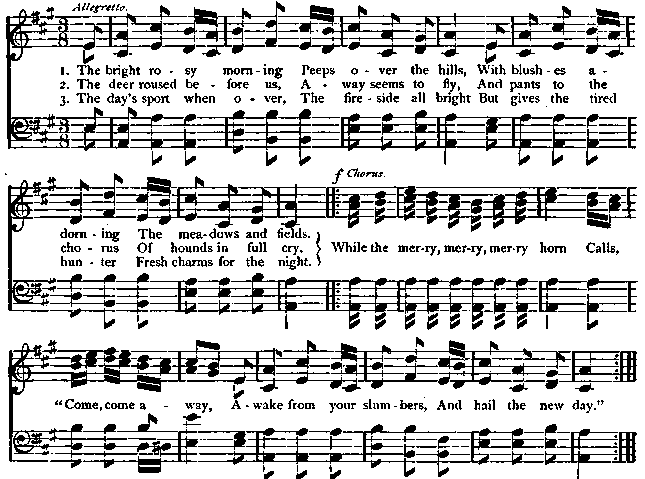Franklin Square Song Collection - online songbook
200 favorite songs and Hymns for Schools, Homes Lyrics & Sheet Music
| Share page | Visit Us On FB |
|
78 FRANKLIN-SQUARE
The Human Ear.—How do the vibrations of the air speak to your brain? First, I want you to notice how beautifully the outside shell of the ear, or concha, as it is called, is curved so that any movement of the air coming to it from the front is caught in it and at once reflected into the opening of the ear. When the air-waves from any quarter have passed in at the opening of your ear, they move all the air in the passage which is called the auditory, or hearing, canal. This canal is lined with little hairs to keep out insects and dust, and the wax which collects in it serves the same purpose. But if too much wax collects, it prevents the air from playing well upon the drum, and therefore makes you deaf. Across the end of this canal a membrane, partly called the tympanum, is stretched, like th; parchment over the head of a drum, and it is this membrane which moves to and fro as the air-waves strike on it. A violent |
SONG COLLECTION
blow on the ear will sometimes break this delicate membrane, or injure it, and therefore it is very wrong to hit a person violently on the ear. On the other side of this membrane, inside the ear, there is air, which fills the whole of the inner chamber and the tube which runs down into the throat. Now, as the drum of the ear is driven to and fro by the soundwaves, it naturally moves the air in the cavity behind it, and also sets in motion here three most curious little bones. The first of these bones is fastened to the middle of the drumhead so that it moves to and fro every time this membrane quivers. The head of this bone fits into a hole in the next bone, the anvil, and is fastened to it by muscles, so as to drag it along with it; but, the muscles being elastic, it can draw back a little from the anvil, and thus give it a blow each time it comes back. This anvil is, in its turn, very firmly fixed to the little bone shaped like a |
||
|
THE BRIGHT, ROSY MORNING. |
|||
|
|
|||
 |
|||
|
|
|||
|
stirrup at the end of the chain. This stirrup rests upon a curious body, which looks like a snail-shell with tubes coming out of it. This body, which is called the labyrinth, is made of bone, but it has two little windows in it, one covered only by a membrane, while the other has the head of the stirrup resting upon it. Now you will readily understand that when the air in the auditory canal shakes the drumhead to and fro, this membrane must drag the hammer, the anvil, and the stirrup. Each time the drum goes in, the hammer will hit the anvil, and drive the stirrup against the little window; every time it goes out it will draw the hammer, the anvil, and the stirrup out again, ready for another blow. Thus the stirrup is always playing upon this little window. Meanwhile, inside the bony labyrinth there is a fluid like water, and along the little passages are very fine hairs, which wave to and fro like |
reeds; and whenever the stirrup hits at the little window, the fluid moves these hairs to and fro, and they irritate the ends of a nerve, and this nerve carries the message to the brain. There are also some curious little stones called otoliths, lying in some parts of this fluid, and they, by their rolling to and fro, probably keep up the motion and prolong the sound. You must not imagine we have explained here the many intricacies which occur in the ear. We can only hope to give you a faint idea of it, so that you may picture to yourselves the airwaves moving backwards and forward in the canal of your ear, then the tympanum vibrating to and fro. the hammer hitting the anvil, the stirrup knocking at the little window, the fluid waving the fine hairs and rolling the tiny stones, the end of the nerve quivering, and then in some marvelous way (hew we know not) the brain hearing the message.—Buckley. |
||